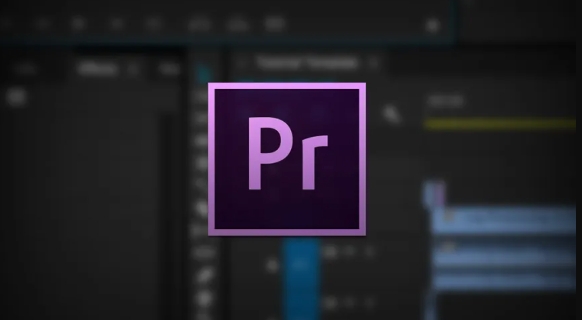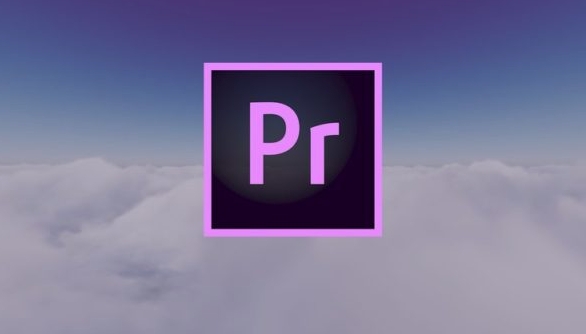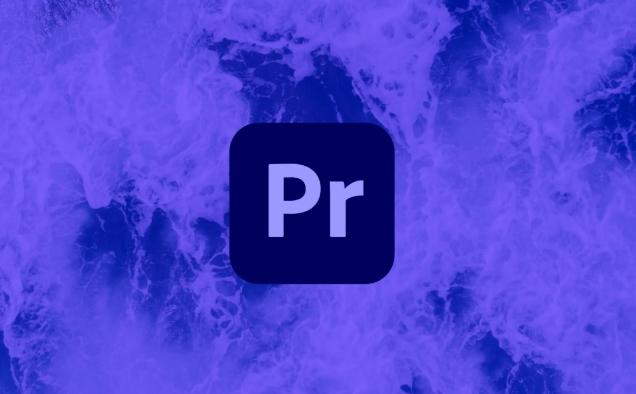how to use the track matte key in Premiere Pro
Use Track Matte Key in Premiere Pro to control the display range of another layer through the brightness or transparency of one layer. 1. It is often used in scenes such as text masking, graphic outline display, and video embedding medium shapes; 2. The setting steps include: putting the content video on the upper layer, putting the mask layer down, applying the Track Matte Key and setting Matte to the lower layer; 3. Supporting two modes: Luma Matte (based on brightness) and Alpha Matte (based on transparency), and you can check the Reverse inverting mask effect. Master the layer order, Matte type selection and Reverse status to achieve diverse creative effects.

Use Track Matte Key in Premiere Pro mainly to control the display range of another layer using the brightness or transparency of one layer. Simply put, it is a "template" that tells you which parts should be displayed and which parts should be transparent.

Under what circumstances should I use Track Matte Key?
This function is especially suitable for text masking, graphic outline display, or embedding videos into a shape. For example, if you want a video to be displayed only inside the text and the outside part is hidden, you can use Track Matte Key.

Common application scenarios include:
- Video content only appears in text
- Images are displayed only within the shape layer range
- Dynamic transition effect
How to set up a Track Matte Key?
The operation is actually not difficult, but the order and hierarchy relationship must be clarified. Here are the basic steps:

- Put the video you want as "content" on top (such as video clips)
- Put the layer you want as a "mask" below (such as text or shape)
- Apply Track Matte Key effect to the above layer
- Confirm that "Use Composition's Alpha" is closed in the Effect Control Panel
- Set Matte to the layer below
In this way, the content above will only be displayed through the shape of the layer below.
Note: If you see that the picture is completely black or has not changed, it may be that the layer order is reversed, or the Matting layer itself does not have appropriate light and dark contrast (if the brightness is used as a mask).
Two modes of Track Matte Key: Luma and Alpha
Track Matte Key has two options: Luma Matte and Alpha Matte , the difference is that they are based on different information.
- Luma Matte : Determine the transparent area based on the brightness information of the layer below. The content is displayed in a bright place, and the dark place is transparent.
- Alpha Matte : Determines based on the alpha channel (that is, transparency) of the layer below. Show in colored areas, and transparent areas are hidden.
For example, if you are using pure white text on a black background, selecting Luma Matte can achieve text masking; if your text itself is a PNG with a transparent background, then choosing Alpha Matte is more suitable.
In addition, you can also check "Reverse" to reverse the effect of the black and white area, which is equivalent to reverse the masking effect.
Basically that's it. Just remember the key points: layer order, Matte type selection, and whether Reverse needs to be turned on , you can flexibly use Track Matte Key to create various creative effects.
The above is the detailed content of how to use the track matte key in Premiere Pro. For more information, please follow other related articles on the PHP Chinese website!

Hot AI Tools

Undress AI Tool
Undress images for free

Undresser.AI Undress
AI-powered app for creating realistic nude photos

AI Clothes Remover
Online AI tool for removing clothes from photos.

Clothoff.io
AI clothes remover

Video Face Swap
Swap faces in any video effortlessly with our completely free AI face swap tool!

Hot Article

Hot Tools

Notepad++7.3.1
Easy-to-use and free code editor

SublimeText3 Chinese version
Chinese version, very easy to use

Zend Studio 13.0.1
Powerful PHP integrated development environment

Dreamweaver CS6
Visual web development tools

SublimeText3 Mac version
God-level code editing software (SublimeText3)
 how to create a timecode overlay in Premiere Pro
Jul 19, 2025 am 01:23 AM
how to create a timecode overlay in Premiere Pro
Jul 19, 2025 am 01:23 AM
There are two ways to add time code overlays in PremierePro: visual time code and metadata embedding. 1. The visual time code is realized through the "time code" effect, which is suitable for the film review stage, and the font, position and other styles can be adjusted; 2. Metadata embedding is checked "Write time code to video" when exporting, which is suitable for delivery and is supported for MP4 and MOV formats. Pay attention to the starting time code setting, timeline continuity and software version compatibility issues during operation.
 what is a MOGRT file for Premiere Pro
Jul 19, 2025 am 01:04 AM
what is a MOGRT file for Premiere Pro
Jul 19, 2025 am 01:04 AM
AMOGRTfileisamotiongraphicstemplateforAdobePremiereProthatenablesquickimportandcustomizationofanimatedelements.Itcontainspre-builtanimationswithadjustablecontrolsfortext,color,duration,andlayoutwithoutleavingPremierePro.Commonusesincludelowerthirds,t
 how to unlink audio and video in Premiere Pro
Jul 16, 2025 am 12:13 AM
how to unlink audio and video in Premiere Pro
Jul 16, 2025 am 12:13 AM
The first step in separating audio and video in PremierePro is to use the Unlink feature. Right-click the clip on the timeline → select "Unlink" to unlink the audio and video synchronous binding and allow individual movement; if you need to completely delete a certain part, you can expand the track content → select the unnecessary part → press Delete to delete; after the processing is completed, you can recombine the audio and video by manually aligning or using "Create Multi-Track Selection" (Ctrl/Cmd G). It should be noted that "Unlink" is not a permanent split, and the association can still be restored (right-click → "Relink"), but it is difficult to restore after export. It is recommended to back up the project file before operation.
 how to use the track matte key in Premiere Pro
Jul 25, 2025 am 01:18 AM
how to use the track matte key in Premiere Pro
Jul 25, 2025 am 01:18 AM
Use TrackMatteKey in PremierePro to control the display range of another layer through the brightness or transparency of one layer. 1. Commonly used in scenes such as text masking, graphic outline display, and video embedding medium shape; 2. Setting steps include: putting the content video on the upper layer, putting the mask layer down layer, applying TrackMatteKey and setting Matte to the lower layer; 3. Supporting two modes: LumaMatte (based on brightness) and AlphaMatte (based on transparency), and you can check the Reverse inverting mask effect. Master the layer order, Matte type selection and Reverse status to achieve diverse creative effects.
 how to automatically duck music in Premiere Pro
Jul 17, 2025 am 12:28 AM
how to automatically duck music in Premiere Pro
Jul 17, 2025 am 12:28 AM
ToachieveaudioduckinginPremierePro,usetheEssentialSoundpanelforautomaticadjustmentsormanualkeyframingformorecontrol.First,ensuredialogueandmusicareonseparatelabeledtracks.IntheEssentialSoundpanel,selectthemusicclip,enable“AutoDuck,”andchoosethevoiceo
 how to edit 360 video in Premiere Pro
Jul 18, 2025 am 12:37 AM
how to edit 360 video in Premiere Pro
Jul 18, 2025 am 12:37 AM
The key to editing 360 videos in PremierePro is to preserve spatial orientation information and correctly set VR properties. 1. After importing, right-click the material and select "Set as VR material" or specify an isometric columnar projection format in the sequence settings; 2. Use the VR viewing angle tool to adjust the default viewing direction to ensure visual consistency; 3. Avoid fast mirror cutting and strong directional transitions during editing, and place the subtitles in the center of the field of view; 4. When exporting, check "VR Video", select the appropriate resolution and bit rate, and test the playback effect to ensure no deformation or black edge problems.
 how to clear media cache in Premiere Pro
Jul 23, 2025 am 01:29 AM
how to clear media cache in Premiere Pro
Jul 23, 2025 am 01:29 AM
PremierePro media cache will occupy a lot of space as the usage time increases. Cleaning methods include: 1. Manually delete .cfa and .exa files in the cache folder, with the path to Windows system C:\Users\username\AppData\Roaming\Adobe\Common\MediaCache or Mac system/Users/Users/Users/Username/Library/Caches/Adobe/Common/MediaCacheFiles; 2. Use Premiere built-in functions to clean it through "File>MediaCache>Delete Media Cache Files"; 3. Regular maintenance recommended to clean it after completing the project
 how to change the playback resolution in Premiere Pro
Jul 25, 2025 am 02:24 AM
how to change the playback resolution in Premiere Pro
Jul 25, 2025 am 02:24 AM
There are three ways to adjust the playback resolution in PremierePro. First, modify the default playback resolution through "Sequence Settings". After opening the project, click "Sequence" > "Sequence Settings" in the top menu, and select the required resolution such as 1/2, 1/4 or custom ratio to save it; second, temporarily adjust the playback resolution, you can click the setting icon in the lower right corner of the program monitor and select "Scaling Scale" or "Resolution" to achieve it; third, adjust the global playback performance settings, and configure the proxy format, hardware accelerated decoding and playback performance options through "File" > "Project Settings" > "Media Collection and Cache" to optimize the smoothness of high-resolution video playback.







